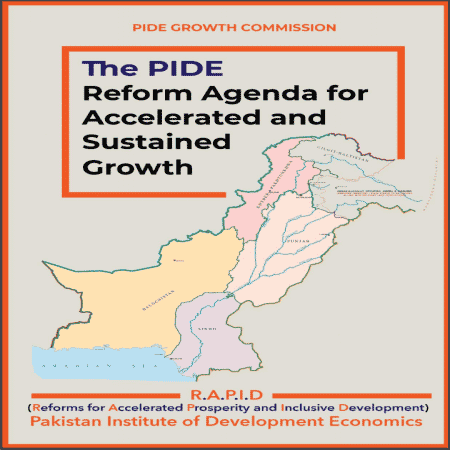
Pakistan Institute of Development Economics
- Home
Our Portals
MenuMenuMenuMenuMenuMenuMenu - ResearchMenuMenuMenuMenuMenuMenuMenu
- Discourse
- The PDR
- Our Researchers
- Academics
- Degree Verification
- Thesis Portal
- Our Portals

PIDE’s Reform Agenda to Achieve Sustainable Growth in the Agriculture Sector
The agriculture sector is one of the main contributors to not only our domestic economy, but exports as well. But sadly its growth is languishing. Put another way, agriculture sector accounts for 19.2% of GDP and employs 38.5% of our labor force. It contributes nearly one-fourth of industrial value-added and delivers nearly 80% of the total value of our exports.
Ninety percent of our cultivated land is under five major crops: wheat, rice, cotton, sugarcane, and maize, leaving only about 10% for horticulture and other high value crops. But historical data reveals that except for maize, crop yields have barely risen in decades. So, what is the way forward, and how do we increase our agricultural sector productivity and growth?
We know the causes behind our faltering agricultural growth. They primarily revolve around low farm-level productivity. This results in high unit production costs, lack of competitiveness; distorted efficient cropping patterns, interference in input-output markets; limited diversification into high value crops; and large herds of low yield animals.
PIDE’s Reform Agenda for Sustained Growth provides a groundbreaking layout to bolster the dwindling 2% growth of the sector. PIDE foresees 6% growth by reducing government footprint on the one hand, and letting markets work on the other hand.
Input-output markets need streamlining by reducing the government footprint and allowing the private sector to take center stage. That in no way means that the role of the government will be any less vital than before. The government will continue to be crucial in improving the regulatory framework and effectively implementing it to achieve market efficiency. Improving the regulatory framework in the markets for land, water and seed/bovine semen will result in significant increases in productivity.
Due to lack of authenticated land-record and lengthy land transaction processes, only a few land transaction happens. Thus, land does not move from less to more productive owners through marketing mechanism. We need to digitize land records to speed up the process of land transfer. This will allow more productive individuals access to land.
Fixed share-based water allocation (mainly determined by political rather than economic consideration) among provinces and regions is an inefficient mechanism. It impedes provinces/regions from bidding for water based on economic returns. Proper water pricing would lead to efficient cropping patterns with higher profitability and employment opportunity. Allocation of water, based on open auction, can lead to efficient utilization of water. Water can flow to where it has most economic benefit.
Seed is a vital input, but its market appears completely mismanaged. In the absence of financial incentives, breeders are reluctant to invest additional efforts to develop new varieties. In the absence of quality control, price competition has led to the market for seeds developing into as lemon market. Unregistered firms/groups (progressive farmers, breeders, general retailers, etc.) sell seed/semen without proper labeling. Even registered firms follow the similar practices – discourages the farmers to make investment in more productive seed/semen.
An unregulated seed market promotes lemons (low quality seed) in the market. The absence of intellectual property right and cumbersome process of approval of new varieties is discouraging international companies to invest in developing any new varieties. A similar phenomenon of free delivery but low quality of extension services by public sector exists – leading to lemon market of extension services.
The government heavily influences output markets by fixing of minimum support prices, providing input subsidies, restricting movements of agriculture commodities, and imposing tariff/subsidy on export and import. All these interventions affect consumer and producer welfare and puts fiscal burden. For instance, consumers pay up to 50% higher prices than the competitive international price of wheat and sugar. On the flip side, general perception is that producers also don’t get the announced minimum price for their products.
Government stores about 80% of marketable wheat and spends about PKR 50 billion every year excluding handling and wastage cost. Government interventions also end up discouraging the participation of the private sector in wheat marketing. These factors have created a circular debt of PKR 700 billion in wheat storage, strongly indicating that wheat storage by the government is not a sustainable activity.
A better alternative is to encourage future markets of agricultural commodities through appropriate fiscal measures and removal of constraints. We can announce a broad band of upper and lower prices in each essential food commodities to indicate the limits of government. Beyond this government will be bound to intervene in the market to ensure food security to consumers and minimum price to producers.
There are a number of signs in the economy that growth of the agriculture sector is being hampered by the footprint of the government. The government would be well advised to consider the areas highlighted above to reduce the size of its footprint in the agriculture sector. Focusing instead on providing a conducive regulatory framework for the private sector to take center stage and drive growth in the sector would be a far better alternative.
Download full PDF


